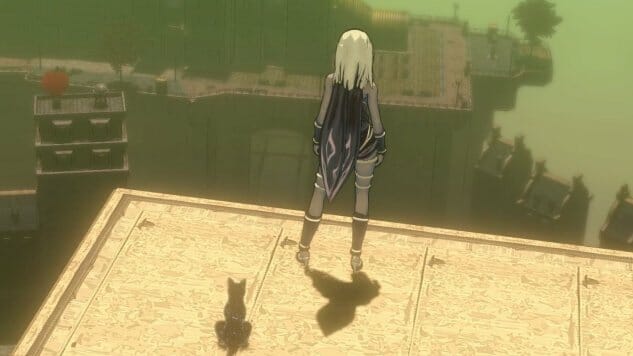Gravity Rush Remastered: Never Let Me Down

Gravity Rush is as strange a game now as it was back when it first premiered on the Playstation Vita four years ago. With its cel shading, its Jean Giraud aesthetic and its Miyazaki storytelling, it looks and feels like no other game. And few games have captured the inspiring freedom and wonder of being able to fly so powerfully. In its best moments, Gravity Rush is the Superman game no one’s been able to get right. I would often soar through Hekseville at high speed, totally unfettered by the ground, reminded of why I looked back so fondly at this game and can’t wait for a sequel (which is undoubtedly the reason this HD remaster is around). But more often, Gravity Rush wrestles its central conceit into the ground, snuffing out much of the appeal of having a superpower in the first place.
Maybe that’s the point: even with her miraculous ability, protagonist Kat is made into an errand girl for most of the plot, throwing paintings into the garbage out back and ferrying people from one spot in town to the next. By bending gravity to her whims, she zips around anywhere she pleases in a matter of seconds, but still has to deal with people’s bullshit. All Kat wants is a place to call her own and the right to fly wherever she wants. Instead, she’s left to clean up the fallout of other people’s bad decisions. A lot of these tasks feel like grunt work, and more than once I held back the urge to yell “do you know who I am?!” at fictional characters.
That aspect of turning the wondrous into the mundane is certainly there, but I don’t buy that it’s the point. Gravity Rush exudes too much wonder for that. Its story soars to some interesting places, but stays fairly light in tone, hitting some downer notes along the way but never letting you dawdle for too long. Most of the time, it’s caught up in a childlike glee, eager as you are to see what’s around the corner as Kat develops her powers and realizes she can help people with them.
A few missions offer glimpses into the kind of diverse, uplifting experience Gravity Rush could have been. One mission has you falling down a tunnel thousands of yards deep, and while you’re faced with dozens of monsters to fight, you can just as easily fall right past them. If you do, you’re left with minutes of nothing but gravity-powered free fall. That might sound boring, but it’s among the best moments in the game. In that massive fall, I had more freedom to use my powers, or just let myself experience the joy of not having to touch the ground for a while.
A couple of other moments gesture at this feeling. Another mission cuts off access to most of your powers, but plants you in a surreal white space as you jump on blocks and gravity-shifting areas to get to your destination. It’s not flashy, but it gets at the same sense of removing the self from the world as being able to fly does. Gravity Rush constantly hints at this freedom but almost never lets you fully delve into it.
Not that the Earth can’t be fun. When combat works, its mix of character-action games like Devil May Cry and the fighter jet extreme-ness of After Burner Climax make for something genuinely novel. You can kick your enemies (most of which are black, amorphous blobs with weak points called Nevi) the old-fashioned way, but it’s so much more fun (and necessary) to lock onto an enemy hundreds of yards away and land a flying kick seconds later, only to immediately turn heel and lock onto your next target. The camera can barely keep up with you, but it’s a good kind of disorienting most of the time. And while most of the bosses don’t move beyond “flying target you need to kick in the weak point,” the mere act of flying at the enemy at high speed is enough to see you through the eight to ten hours the game lasts.
